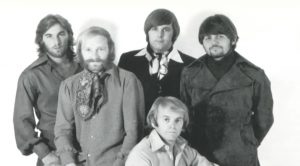The Mystery Behind The Death Of Bassist Kristen Pfaff

via laalpaprika / Youtube
Kristen Pfaff’s journey is a fascinating paradox. On the surface, it’s a classic tale of academic success – a bright student excelling in a private school environment. But beneath this lies a hidden fire, a passion for music that would propel her from the classroom to the stage.
Her talent wasn’t confined to textbooks – she possessed a raw musical power that would make her a driving force behind the iconic alternative rock band, Hole. However, Pfaff’s story takes a tragic turn.
Her undeniable brilliance on the bass guitar, credited with elevating Hole’s music to new heights, was tragically cut short. Her death, attributed to heroin use, became a chilling echo of a similar fate that befell other talented artists of her era. This is the story of Kristen Pfaff – a life brimming with potential, marked by both dazzling success and heartbreaking loss.
From Beginner to Bass Prodigy
Kristen’s warmth and charisma were undeniable. After graduating, she embraced a new passion in Minneapolis – the bass guitar. Mastering it with impressive speed, she co-founded the band Janitor Joe in 1991 alongside Joachim Breuer and Matt Entsminger. This Minneapolis outfit wouldn’t just be a creative outlet; it would become the springboard for a life-changing opportunity.
Janitor Joe’s national tours caught the attention of the right people. Hole’s guitarist, Eric Erlandson, and frontwoman, Courtney Love, were searching for a new bassist after a fallout with Jill Emery.
Pfaff initially turned down their offer, drawn back to the familiar comfort of Minneapolis. But for Erlandson and Love, the search was over. They knew Kristen Pfaff was the missing piece for Hole.
https://twitter.com/lazarusheart69/status/1689704721383047169
A Difficult Decision and a Defining Album
Filling the bass vacancy became crucial for Hole, especially after recruiting drummer Patty Schemel. They needed a skilled bassist for this new chapter. Pfaff eventually accepted their offer, influenced by her father, Norman. He saw it as a smart career move, joining a band on the rise with a successful debut album, Pretty on the Inside.
However, her mother, Janet, held reservations about the move, concerns that would tragically foreshadow future events. In 1993, Pfaff embraced the opportunity, moving to Seattle, the epicenter of the grunge scene. She joined Hole and began work on their major label debut, Live Through This, released in 1994.
According to guitarist Eric Erlandson, Pfaff’s arrival marked a turning point for the band. “Hole became a real band” after hiring her, he stated. This album, featuring iconic alt-rock anthems like “Miss World”, “Doll Parts”, and “Violet”, is considered by many to be their masterpiece, with Pfaff’s assertive bass lines forming a crucial foundation.
A Turbulent Time in Seattle
Despite the creative success with Hole, Pfaff’s time in Seattle wasn’t without personal struggles. She became romantically involved with guitarist Eric, but their split during album production impacted the band. However, they remained friends.
A darker aspect of the era was substance abuse within the group, particularly for Pfaff and drummer Patty, who secretly battled drug addiction. While Pfaff reportedly dabbled in drugs before Seattle, the scene there was far more intense, with heroin readily available. Many around her were addicts.
While Pfaff and Schemel engaged in drug binges together, reports suggest her use was less severe than some in her circle. Erlandson believes Pfaff’s heroin use stemmed from feelings of disconnect in this new city and the “new friends” she made. He claims he warned her against it, stating in SPIN magazine, “The only way you can survive in this town is if you don’t make those connections.”
A Turning Point and a Tragic Loss
February 1994 marked a turning point for Pfaff. Battling heroin addiction, she returned to Minneapolis for rehab after a near-fatal overdose. The spring brought further changes – she left Hole due to a growing rift with Love, rumored to be fueled by Pfaff’s friendship with Kurt Cobain.
Pfaff rejoined Janitor Joe for a tour, a chance to reconnect with old friends. While planning to return to Seattle in June to collect belongings and finally settle back in Minneapolis, she was deeply affected by Cobain’s suicide in April, another victim of heroin addiction.
Pfaff’s initial plan was to return to Seattle on June 14th, 1994. Her mother, reportedly apprehensive about her daughter going back to a troubled environment, arranged for a cousin who worked as a security guard to accompany her. However, an extended tour with Janitor Joe forced a last-minute change. With her cousin unavailable, Pfaff would face Seattle alone.
https://twitter.com/despairbabe/status/868230634401083393
A Tragic End in Seattle
Pfaff wasn’t alone on her final trip back to Seattle. She enlisted her friend, Paul Erickson, to accompany her. Arriving on June 15th, they packed her belongings into a trailer, planning to leave for the East Coast the next day. Erickson even slept in the car that night due to local theft concerns. Pfaff reportedly called her Janitor Joe bandmates, expressing her joy at leaving Seattle permanently.
Later that evening, Erickson saw Eric Erlandson visit the apartment for about a half hour. After Erlandson left, Erickson checked on Pfaff, hearing her snoring in the locked bathroom – a habit her family confirmed. He then went to sleep himself.
The next morning, Erickson realized something was wrong. The bathroom door remained locked, and Pfaff didn’t respond. Forced to break down the door, he found Pfaff unresponsive in the bathtub with a shallow amount of water.
Sadly, paramedics arrived too late, and she was pronounced dead at 27 years old. Police discovered drug paraphernalia and syringes in a cosmetic bag, and an autopsy confirmed Pfaff’s death by “acute opiate intoxication.”
Conspiracy Theories Cloud the Tragedy
Pfaff’s death remains shrouded in mystery, largely fueled by her mother Janet’s refusal to accept the official explanation. In the controversial 2004 book Love and Death, Janet vehemently rejects the findings of the heroin overdose.
Authored by Ian Halperin and Max Wallace, the book is known for its sensational claims, including Cobain’s murder, and is seen as an extension of their equally divisive 1998 publication on the topic.
Janet’s skepticism finds some basis in Pfaff’s supposed sobriety leading up to her death. It appears to her as a locked-room mystery. She pressured authorities to investigate the case as a homicide, but the police found no evidence to support this theory.
Furthermore, some fans point to additional inconsistencies: Pfaff’s reported clean state and a missing portion of her journal found at the scene. These details continue to fuel speculation about the events surrounding her tragic end.
More Doubts and Conspiracy Theories
The circumstances surrounding Pfaff’s death have fueled speculation for years. In Love and Death, Kristen’s mother Janet highlights Dr. Nikolas Hartshorne, the coroner who performed both Cobain and Pfaff’s autopsies, as a close friend of Courtney Love.
While not directly accusing anyone, Janet presents this as a significant conflict of interest. Norman Pfaff, Kristen’s father, also maintains his daughter was not a heroin addict at the time and was actively seeking recovery. This view is reportedly corroborated by friends and staff at Hole’s record label, Geffen.
Conspiracy theorists point to another event as evidence of a cover-up: the murder of police officer Antonio Terry just days before Pfaff’s death. Terry, according to Love and Death, was apparently involved in the investigation of Cobain’s missing person report.
The book suggests his murder, while seemingly unrelated to Pfaff’s death, diverted attention away from a deeper investigation. Ultimately, readers must decide for themselves whether to believe these claims.
https://twitter.com/UndercoverIndi/status/1529826091602305024
A Heartfelt Loss or Something More?
The circumstances surrounding Kristen Pfaff’s death remain a point of debate. For many, the heartfelt tributes paid by friends and colleagues paint a clear picture – a tragic accident that stole a talented musician.
However, for those who believe there’s more to the story, the unusual details surrounding Pfaff’s passing hold a deeper meaning. They point to the involvement of the same coroner in both Cobain and Pfaff’s autopsies, the reported clean slate Pfaff was striving for, and the strange coincidence of a police officer’s murder just days before.
Ultimately, whether Pfaff’s death was a heartbreaking accident or something more sinister remains a matter of interpretation.












